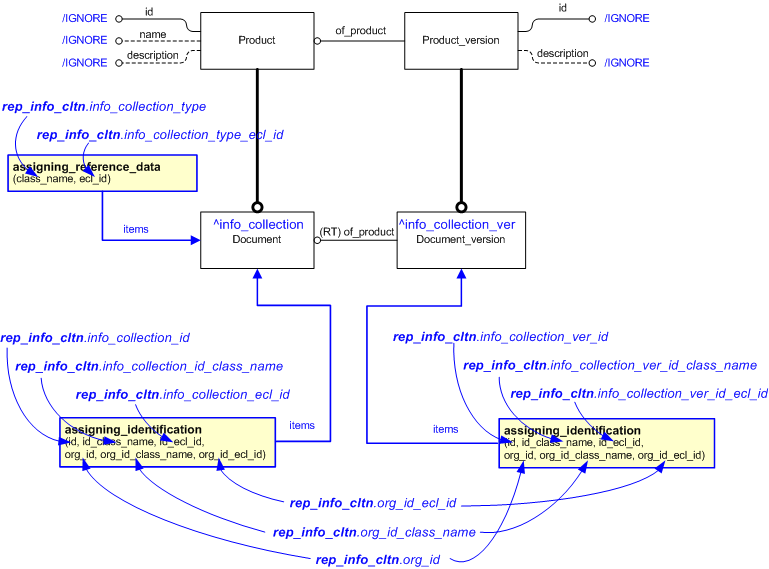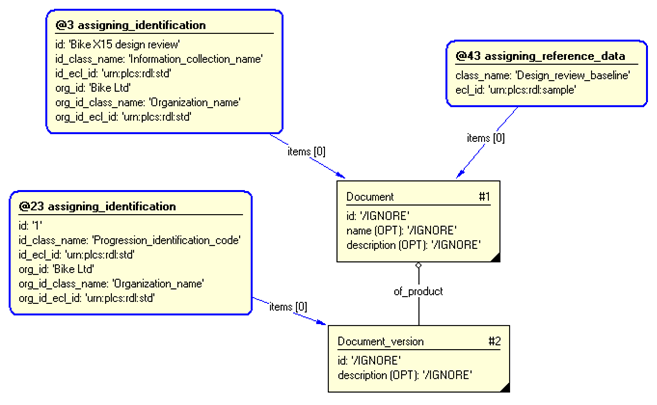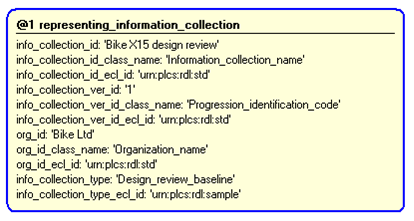Template:— representing_information_collection (rep_info_cltn)
Capability:representing_project_information |
Date: 2010/01/29 13:54:38
Revision: 1.4
|
This section specifies the template representing_information_collection.
NOTE
The template has been defined in the context of the capability
representing_project_information
which provides an overall description of the
relevant parts of the ISO 10303-239 information model and a description
of related templates.
NOTE
An explanation of a template and the associated instantiation path is
provided in the
Template overview
section.
This template describes how to represent an Information collection. An information collection referes to all the data instances
that has been gathered for a specific purpose.
The EXPRESS-G diagram in
Figure
1
shows the templates and EXPRESS entities that are required
to represent the template
"representing_information_collection".
The text highlighted in blue shows the template parameters.
Figure 1 — An EXPRESS-G representation of the Information model for representing_information_collection
The graphic for the template to be used in other EXPRESS-G diagrams
is shown in Figure
2
below.
Figure 2 — The graphical representation of the representing_information_collection template
The following input parameters are defined for this template:
The identification of the information collection.
The name of the
External_class that determines the type of identifier given by the
input parameter @info_collection_id.
The following classes and their sub-classes can be used:
The identification of the version of the defined information collection.
The name of the
External_class that determines the type of identifier given by the
input parameter @info_collection_ver_id.
The following classes and their sub-classes can be used:
The identification or name of the
Organization that
"owns" the identification of the information collection and its version (@info_collection_id and @info_collection_ver_id).
The name of the
External_class that determines
the type of organization identification (@org_id) being used. For example NCAGE code.
The following classes and their sub-classes can be used:
The name of the
External_class that determines
the type of information collection being defined.
The following classes and their sub-classes can be used:
The following reference parameters are defined for this template:
Allow the
Document
entity instantiated in this path to be referenced when this template is used.
Note: The
Document
entity can be referenced in a template path by:
%^target = $representing_information_collection.info_collection%
where
target
is the parameter to which the
Document
is bound.
Allow the
Document_version
entity instantiated in this path to be referenced when this template is used.
%^target = $representing_information_collection.info_collection_ver%
The following parameter combinations specify a uniqueness constraint:
Unique constraint: Unique Information Collection
This rule means that there can be only one information collection
with any given identifier.
Unique constraint: Unique Information Collection Version
This rule means that there can be only one version
of an information collection with any given identifier.
The instantiation path shown below specifies the entities that are to be
instantiated by the template.
A description of templates and the syntax for the instantiation path is
provided in the
Templates Help/Information section.
Document-- Mark the Document entity (representing the Information Collection) as -- referable when this template is used by binding it to the reference -- parameter info_collection %^info_collection =
Document%
Document.id = '/IGNORE'
Document.name = '/IGNORE'
Document.description = '/IGNORE'
-- Provide the role of the Document as an Information Collection, by classification /
assigning_reference_data(
items=^info_collection,
class_name=@info_collection_type,
ecl_id=@info_collection_type_ecl_id)/
-- assign the identification to the Document (Information Collection) /
assigning_identification(
items=^info_collection,
id=@info_collection_id,
id_class_name=@info_collection_id_class_name,
id_ecl_id=@info_collection_id_ecl_id,
org_id=@org_id,
org_id_class_name=@org_id_class_name,
org_id_ecl_id=@org_id_ecl_id)/
-- Mark the Document_version entity (representing the Information Collection Version) -- as referable when this template is used by binding it to the reference -- parameter info_collection_ver Document_version%^info_collection_ver =
Document_version%
Document_version.id = '/IGNORE'
Document_version.description = '/IGNORE'
Document_version.of_product ->
^info_collection
-- assign the identification to the Document_version (Information Collection Version) /
assigning_identification(
items=^info_collection_ver,
id=@info_collection_ver_id,
id_class_name=@info_collection_ver_id_class_name,
id_ecl_id=@info_collection_ver_id_ecl_id,
org_id=@org_id,
org_id_class_name=@org_id_class_name,
org_id_ecl_id=@org_id_ecl_id)/
The following entities are instantiated with attributes as specified:
The instance diagram in Figure
3
shows an example of the EXPRESS entities and templates that are instantiated by the template:
/representing_information_collection(info_collection_id='Bike X15 design review', info_collection_id_class_name='Information_collection_name', info_collection_id_ecl_id='urn:plcs:rdl:std', info_collection_ver_id='1', info_collection_ver_id_class_name='Progression_identification_code', info_collection_ver_id_ecl_id='urn:plcs:rdl:std', org_id='Bike Ltd', org_id_class_name='Organization_name', org_id_ecl_id='urn:plcs:rdl:std', info_collection_type='Design_review_baseline', info_collection_ecl_id='urn:plcs:rdl:sample')/
(an illustration of the consolidated representing_information_collection template is shown in
Figure
4 below.)
Figure 3 — Entities instantiated by representing_information_collection template
The instance diagram in
Figure
4
shows the graphic symbol for the template that is to be
used in other instance diagrams. The example template is:
/representing_information_collection(info_collection_id='Bike X15 design review', info_collection_id_class_name='Information_collection_name', info_collection_id_ecl_id='urn:plcs:rdl:std', info_collection_ver_id='1', info_collection_ver_id_class_name='Progression_identification_code', info_collection_ver_id_ecl_id='urn:plcs:rdl:std', org_id='Bike Ltd', org_id_class_name='Organization_name', org_id_ecl_id='urn:plcs:rdl:std', info_collection_type='Design_review_baseline', info_collection_ecl_id='urn:plcs:rdl:sample')/
Figure 4 — Instantiation of representing_information_collection template
Characterizations
No common characterizations of the template
representing_information_collection
have been identified. However, the ISO 10303-239 EXPRESS model
may enable other assignments to the entities instantiated by the template.




